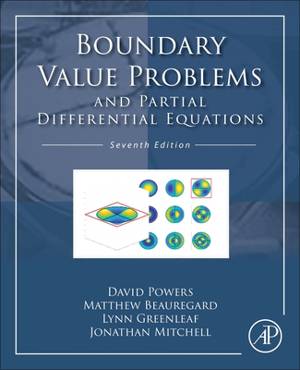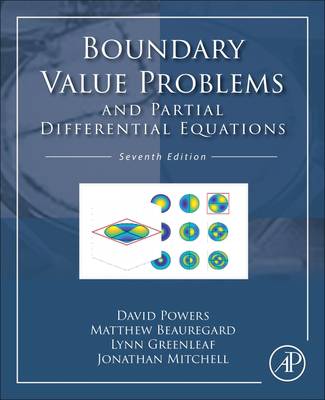
- Afhalen na 1 uur in een winkel met voorraad
- Gratis thuislevering in België vanaf € 30
- Ruim aanbod met 7 miljoen producten
- Afhalen na 1 uur in een winkel met voorraad
- Gratis thuislevering in België vanaf € 30
- Ruim aanbod met 7 miljoen producten
Zoeken
Boundary Value Problems and Partial Differential Equations
David L Powers, Matthew A Beauregard, Lynn Greenleaf, Jonathan Mitchell
Paperback | Engels
€ 209,45
+ 418 punten
Omschrijving
For over fifty years, Boundary Value Problems and Partial Differential Equations, Seventh Edition has provided advanced students an accessible and practical introduction to deriving, solving, and interpreting explicit solutions involving partial differential equations with boundary and initial conditions. Fully revised and now in its Seventh Edition, this valued text aims to be comprehensive without affecting the accessibility and convenience of the original. The resource's main tool is Fourier analysis, but the work covers other techniques, including Laplace transform, Fourier transform, numerical methods, characteristics, and separation of variables, as well, to provide well-rounded coverage. Mathematical modeling techniques are illustrated in derivations, which are widely used in engineering and science. In particular, this includes the modeling of heat distribution, a vibrating string or beam under various boundary conditions and constraints. New to this edition, the text also now uniquely discusses the beam equation. Throughout the text, examples and exercises have been included, pulled from the literature based on popular problems from engineering and science. These include some "outside-the-box" exercises at the end of each chapter, which provide challenging and thought-provoking practice that can also be used to promote classroom discussion. Chapters also include Projects, problems that synthesize or dig more deeply into the material that are slightly more involved than standard book exercises, and which are intended to support team solutions. Additional materials, exercises, animations, and more are also accessible to students via links and in-text QR codes to support practice and subject mastery.
Specificaties
Betrokkenen
- Auteur(s):
- Uitgeverij:
Inhoud
- Aantal bladzijden:
- 500
- Taal:
- Engels
Eigenschappen
- Productcode (EAN):
- 9780443298820
- Verschijningsdatum:
- 23/01/2026
- Uitvoering:
- Paperback
- Formaat:
- Trade paperback (VS)
- Afmetingen:
- 190 mm x 235 mm
- Gewicht:
- 449 g

Alleen bij Standaard Boekhandel
+ 418 punten op je klantenkaart van Standaard Boekhandel
Beoordelingen
We publiceren alleen reviews die voldoen aan de voorwaarden voor reviews. Bekijk onze voorwaarden voor reviews.








